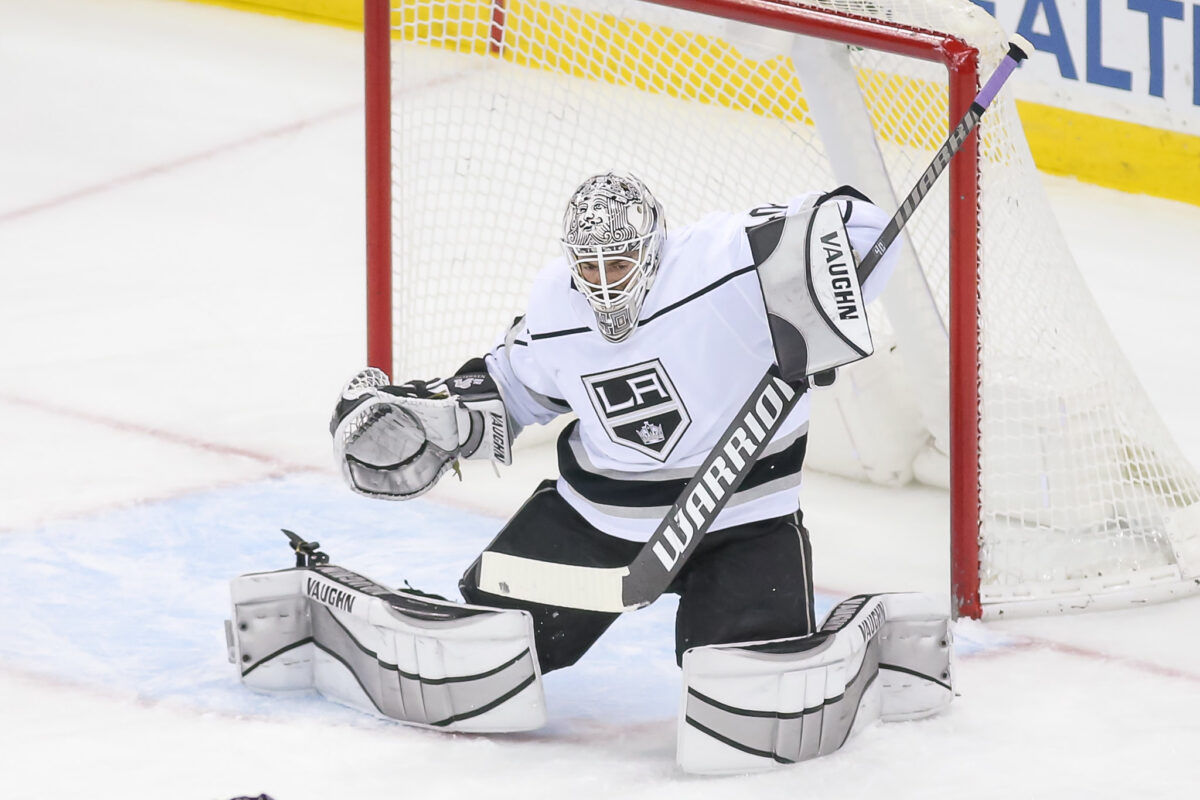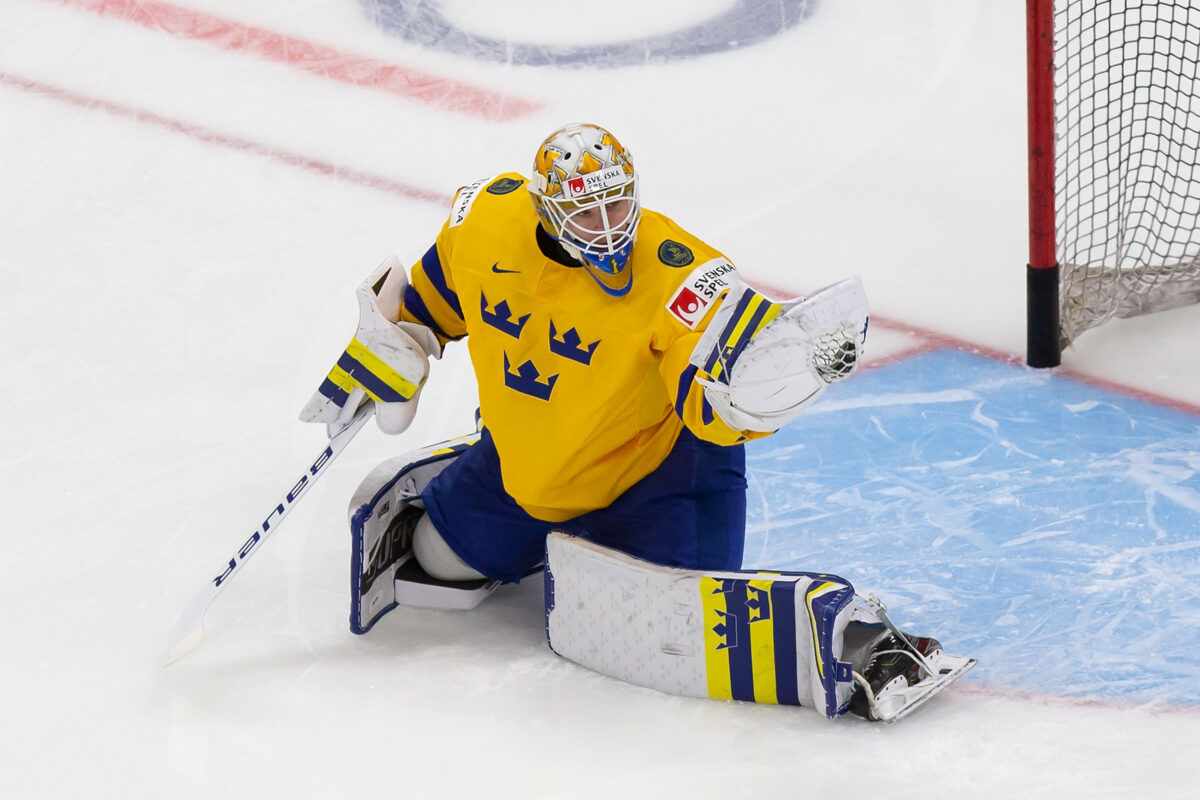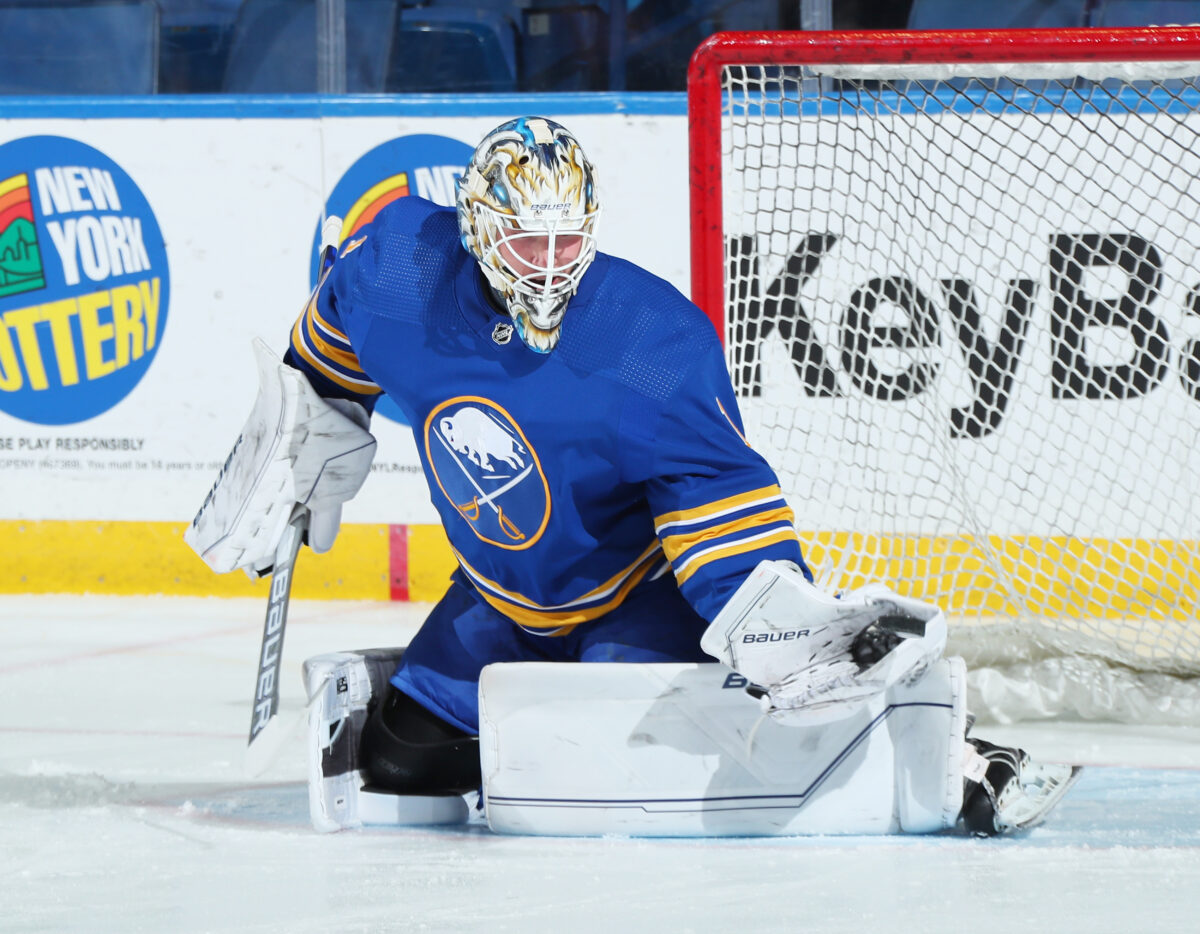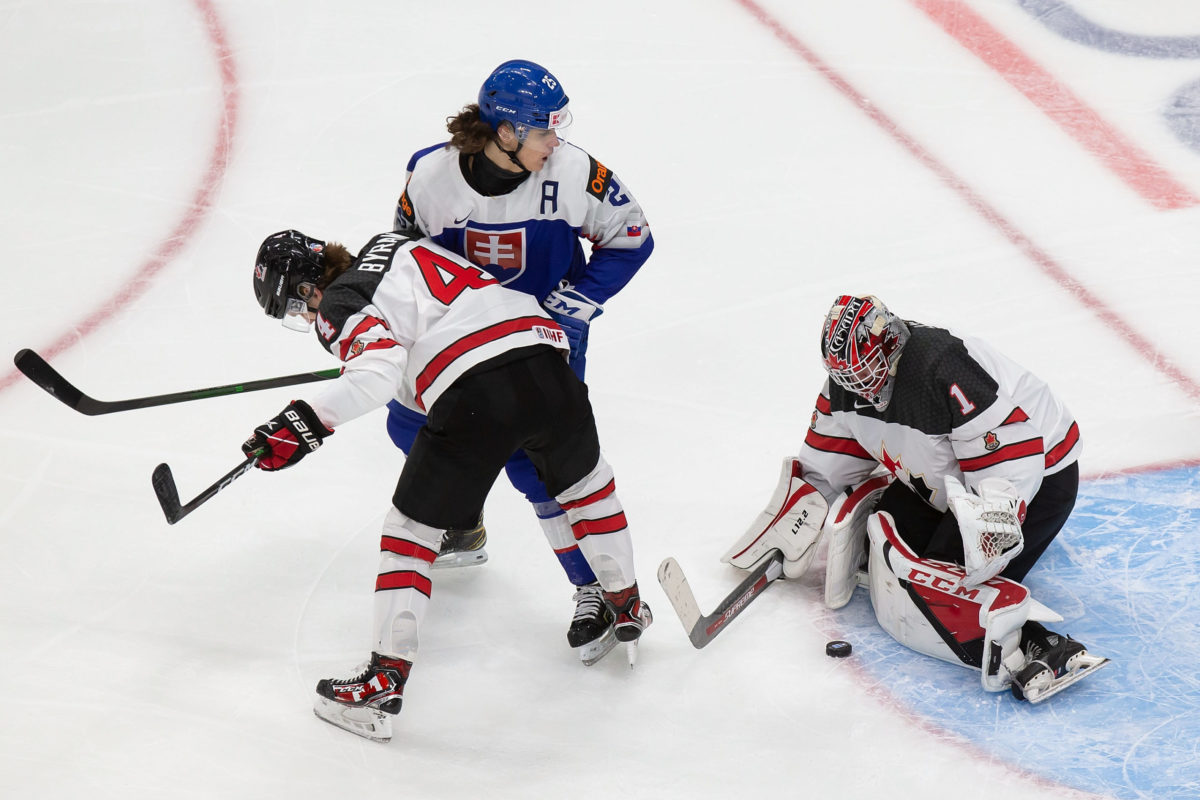With the Stanley Cup Final finishing soon, the offseason rumor mill will begin picking up shortly. With that will come rumors about the Los Angeles Kings targeting big-name forwards and left-shot defensemen, a topic I’ve covered a few times recently. I understand the desire from fans to add one of these players. However, a more sensible target for the team is adding a goalie for the future.
Kings’ Current Situation in Net
One of the tricky things about adding a goalie this summer is the team’s current situation in net. They have $10.8 million tied up in Jonathan Quick and Cal Petersen for the 2022-23 season, and because of this, the team will be sticking with this tandem through next season. After that, they’ll have a tough decision to make if legendary netminder Quick decides he wants to continue his career.
Related: Kings Shouldn’t Be in the Market for Superstar Forward
Last season was a slight return to form for Quick, with his .910 save percentage (SV%) and 2.59 goals against average (GAA) being his best numbers since 2017-18. His 17.8 goals saved above expected (GSAx) also placed him top ten in the league, not surprising for a goalie who’s always thrived at making saves he shouldn’t. Even still, the Kings will need an improvement on Quick if they want to truly take the next step and compete for a Cup. Fortunately, they don’t need to worry about Cup contention for next season and can be fine with Quick in net if he keeps his form from last season. They know he can get them into the playoff, and that has to be the goal. Anything more is gravy for this team.
The issue in net for the Kings doesn’t come from Quick, though; they can ride him into retirement and be happy. The issue comes with Petersen, as the team put their faith in him last summer, agreeing to a 3-year, $15 million contract extension. They felt he was the heir apparent to Quick, giving him the starting spot on opening night, marking the first time Quick wasn’t in net for a season opener since 2008-09. The message was clear. It was Petersen’s net. Unfortunately, Petersen failed to hold onto his net, losing it fairly early in the season after a rough start. He did bounce back in the middle of the season but fell away again near the end. He didn’t get a single start in the postseason, and there are legitimate concerns about his future as a number one goalie.

It feels harsh to say that Petersen doesn’t have a future as a number one goalie after one season where he couldn’t take the reins, but it’s important to remember his age. He isn’t a young up-and-coming goalie in his early 20s; he’s 27 years old and will be 28 before the start of next season. He should be in his prime but is instead fighting to prove he was worth the big investment from general manager Rob Blake. Believers in Petersen would point to former Kings’ goalie Jack Campbell, who finally broke through this season at 30 years old, as proof that Petersen still has a future, but Campbell is the exception, not the rule. I don’t want to entirely give up on Petersen, but it’s hard to have faith in him after last season. At the very least, the team needs to start planning for the possibility that Petersen isn’t the future in net and bolster the prospect pool with a quality goalie.
Speaking of the prospect pool, goalie is by far the weakest spot in the team’s system. The Kings have built up one of the best pools in the league but don’t have a single goalie who looks like a future starter. Matt Vilalta, Lukas Parik, David Hrenak, Jacob Ingham, and Juho Markkanen make up the team’s pipeline. Vilalta is at the top of the pecking order, spending most of the season as the starter with the Ontario Reign, although David Hrenak did look good in his three regular-season games after a solid season in college hockey. Ingham and Parik spent most of their season in the ECHL, leaving little hope for an NHL future. Markkanen is the youngest goalie in the system and put up uninspiring numbers in Switzerland last season. Of their prospects, Vilalta and Hrenak have the best chance of playing in the NHL, but both look to be future backups at best.
Kings’ External Options to Improve
With uncertainty surrounding Petersen’s potential ceiling, Quick’s age, and a lack of reinforcements coming from within the organization, the Kings will have to look externally for help. There’s always the option of drafting a goalie, but this year is a notoriously weak draft for goalies, and the long development path for goalies probably means the Kings will look for more developed prospects. Still, taking one of Tyler Brennan, Topias Leinonen, or Hugo Havelid in the second or third round would make sense. You can never have too many good goalie prospects, and one of them might really pop. Still, any goalie drafted should be in addition to an acquisition, not in place of one.
Targeting a Big Name
With all of the discussion surrounding forwards like Alex DeBrincat or Jakob Chychrun, it might be a big-time goalie prospect that the Kings swing for the fences on. It would take an impressive haul, but Blake should be on the phone to inquire about some of the hottest prospects in net. Both the Minnesota Wild and Nashville Predators will be facing serious cap issues this summer and might be enticed into moving their big prospects in net, Jesper Wallstedt and Yaroslav Askarov, respectively.

Who knows how much the Florida Panthers panic after another disappointing playoff exit. There were rumors that Spencer Knight was in play for Chychrun during the season, and he’s at least worth calling about. Other names like Jeremy Swayman and Dustin Wolf would also be targets, depending on what happens with their teams over the summer. Of course, the chances of grabbing one of these goalies are less than five percent, but it’s worth throwing feelers out.
Look to the Sabres for Help
There is a feeling that the Kings should look to trade from positions of strength this summer, moving a few players from their deep pool of centers and right-shot defensemen. They could find a perfect partner in the Buffalo Sabres, who need right-shot defensemen and have three excellent goalie prospects. Both teams could trade from a point of strength and improve an area of weakness.
Ukko-Pekka Luukkonen
Back in 2017, Ukko-Pekka Luukkonen was a can’t-miss goalie prospect. He was the best goalie in the Ontario Hockey League (OHL) and was the second goalie taken in the 2017 draft, behind only Jake Oettinger. The hype surrounding Luukkonen has fallen away a bit, but that doesn’t mean he isn’t still a good prospect. Standing 6-foot-4, he’s got the build NHL teams covet for their goalies, and at times, he looks like a guaranteed future number one. Unfortunately, there are times when you question if he has an NHL future. There are a lot of inconsistencies in his game, and when he’s on, he’s on, but when he’s off, it’s hard to watch.

He looked decent in his nine NHL games last season, with a .917 SV%, 2.74 GAA, and -0.4 GSAx, all on a weak Sabres team. Another season in the American Hockey League (AHL) is a must for Luukkonen, as he needs time to iron out those inconsistencies, but playing on a high-powered Reign team and working with goaltending coach Matt Millar could go a long way. Trading for Luukkonen comes with the most risk, however, as he would cost the least, and he’s still a fantastic prospect. Another added benefit to Luukkonen is that he should be NHL-ready before the other two goalies I’ll talk about. He could be ready to backup Petersen by the 2023-24 season.
Erik Portillo
I mentioned that Luukkonen has the build NHL teams covet, and the same is true for former third-round pick Erik Portillo. At 6-foot-6, 225 pounds, Portillo uses his size to sit deep in his net and play a very calm game. His toolset is the best among Buffalo’s goalie prospects, possessing not only great size but incredible athleticism to go with it. Like Luukkonen, he struggles with consistency at times, letting in soft goals too frequently, but he’s impossible to score on when at his best. He also needs to improve his rebound control, but that’s something a goalie coach like Millar could fix with relative ease. He’s also one of the best goalies in college hockey when facing breakaways and one-on-one opportunities.
On a stacked University of Michigan team, Portillo posted a .926 SV%, 2.14 GAA, and 31 wins, good for second in the league. Most people considered him one of the best goalies in college hockey last season, with a lot of room to grow still. An added benefit to Portillo is how vocal he is in the net, directing his defensemen and keeping up constant communication, and his ability to play the puck. While these skills aren’t necessities, they are good skills to have. He will be returning to Michigan for his junior year next season and would need at least one season in the AHL before he was ready to challenge for a roster spot. Given his toolset, Portillo’s potential ceiling is limitless, especially if someone like Bill Ranford puts time in with him. There’s a future number one in Portillo, and the Kings could be the perfect place for him.
Devon Levi
I said people viewed Portillo as one of the best goalies in college hockey last season, but those same people would agree that Devon Levi was even better. In fact, he was a Hobey Baker Award finalist, and eventual winner Dryden McKay is the only goalie who was better than Levi. He led the NCAA in SV%, posting a .952, had a 1.54 GAA, and grabbed 21 wins. He was so good that he only allowed more than two goals against in six games all season, a ridiculous stat. A former seventh-round pick, he put his name on the map with an incredible World Juniors performance in 2021, posting a .964 SV%, 0.75 GAA, and three shutouts in seven games during this tournament. He continued this form into college and will be a frontrunner for the Hobey Baker Award next season.

Levi will be the hardest goalie to acquire of these three; he looks like the best prospect and was recently acquired from the Panthers in the trade that sent Sam Reinhart to Florida. He would command a hefty price but appears to be a future number one and could be worth it. Also returning to college for his junior year, he’s still a few seasons away from playing in the NHL but looks like a goalie who can make an impact from day one. An undersized netminder at just 6-foot-0, there are some similarities between Levi and Quick, relying on athleticism and explosive movements to make saves. Levi would set the team up for the next decade in net but will be difficult to acquire.
Kings Should Go Big for a Goalie
With all the discussion about what the Kings “need” this summer, I think goalie is the biggest need. It is the only position where the team has zero top prospects, and the team lacks a clear number one on the NHL roster. The team will need a top-tier goalie if they want to compete for a Cup in the future, and this summer is a good time to acquire that piece. Blake should enquire about some of the league’s best goalie prospects but should especially target the Sabres, looking to swap from positions of strength. Both teams could come away with a true win-win trade.
